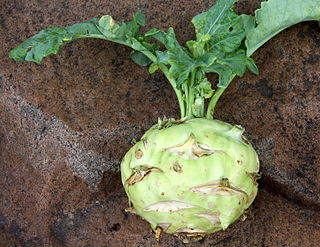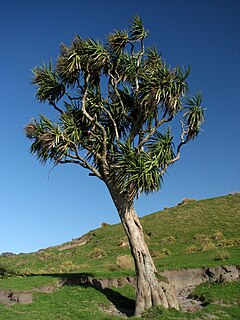
Kohlrabi, also called German turnip, is a biennial vegetable, a low, stout cultivar of wild cabbage. It is the same species as cabbage, broccoli, cauliflower, kale, Brussels sprouts, collard greens, Savoy cabbage, and gai lan.

Cabbage or headed cabbage is a leafy green, red (purple), or white biennial plant grown as an annual vegetable crop for its dense-leaved heads. It is descended from the wild cabbage, B. oleracea var. oleracea, and belongs to the "cole crops", meaning it is closely related to broccoli and cauliflower ; Brussels sprouts ; and savoy cabbage. Brassica rapa is commonly named Chinese, celery or napa cabbage and has many of the same uses. Cabbage is high in nutritional value.

Brassica is a genus of plants in the mustard family (Brassicaceae). The members of the genus are informally known as cruciferous vegetables, cabbages, or mustard plants. Crops from this genus are sometimes called cole crops—derived from the Latin caulis, denoting the stem or stalk of a plant.

Cordyline australis, commonly known as the cabbage tree, cabbage-palm is a widely branched monocot tree endemic to New Zealand.

Chinese cabbage can refer to two groups of Chinese leaf vegetables often used in Chinese cuisine: the Pekinensis Group and the Chinensis Group.

Brassica oleracea is a plant species that includes many common foods as cultivars, including cabbage, broccoli, cauliflower, kale, Brussels sprouts, collard greens, savoy, kohlrabi, and gai lan.

Heart of palm is a vegetable harvested from the inner core and growing bud of certain palm trees. Harvesting of many uncultivated or wild single-stemmed palms results in palm tree death. However, other palm species are clonal or multi-stemmed plants and moderate harvesting will not kill the entire clonal palm. Heart of palm may be eaten on its own, and often it is eaten in a salad.

Savoy cabbage, is a variety of the plant species Brassica oleracea. Savoy cabbage is a winter vegetable and one of several cabbage varieties. It is thought to originate from England and the Netherlands. In the 18th century, it was introduced into Germany as "Savoyer Kohl". It is named after the Savoy Region in France. It is known as 'cavolo verza' in Italy. It has crinkled, emerald green leaves. The leaves are crunchy and tender. Known cultivars include 'Savoy King', 'Tundra' and 'Winter King'.
Cabbage tree is a common name for several plant species:

The acephala group refers to any type of Brassica which grows without the central 'head' typical of many varieties of cabbage. These are included within the species Brassica oleracea, such as Kale. The name literally means "without a head" in contrast to those varieties known as capitata or "with a head". This group includes a number of species, both wild and cultivated, many of which are grown for their edible leaves and flowers.

Euterpe is a genus of palm tree, containing eight species that are native to Central America and the Yucatan, the West Indies, and South America, from Belize and the Windward Islands southward to Brazil, Peru and Argentina. These palms grow mainly in swamps and floodplains.

Livistona mariae, also known as the central Australian or red cabbage palm, is a species of flowering plant in the family Arecaceae.

Euterpe precatoria is a tall, slender-stemmed, pinnate-leaved palm native to Central and South America and Trinidad and Tobago. E. precatoria is used commercially to produce fruits, although Euterpe oleracea is more commonly cultivated due to its larger fruits.

Sabal palmetto, also known as cabbage-palm, palmetto, cabbage palmetto, blue palmetto, Carolina palmetto, common palmetto, swamp cabbage and sabal palm, is one of 15 species of palmetto palm. It is native to the southern United States, as well as Cuba, the Turks and Caicos Islands, and the Bahamas.

Roystonea oleracea, sometimes known as the Caribbean royal palm, palmiste, imperial palm or cabbage palm, is a species of palm which is native to the Lesser Antilles, Colombia, Venezuela, and Trinidad and Tobago. It is also reportedly naturalized in Guyana and on the islands of Mauritius and Réunion in the Indian Ocean.
Roystonea princeps, commonly known as Morass cabbage palm or Morass royal palm, is a species of palm which is endemic to western Jamaica.
P. elegans may refer to any of the following species:

Cabbage Tree Island, also known as the John Gould Nature Reserve, is a protected nature reserve and uninhabited continental island lying 1.4 km (0.87 mi) off the mouth of Port Stephens on the coast of New South Wales, Australia. The 30 ha (74-acre) reserve and island is named for the Cabbage-tree Palms in the two gullies on the island's western side which are the nesting site of Goulds petrel. It is the principal breeding site of the nominate subspecies of the threatened Gould's petrel and, with the nearby Boondelbah Island where there is also a small colony, has been classified by BirdLife International as an Important Bird Area. Both Cabbage Tree and Boondelbah Islands are gazetted nature reserves under the New South Wales National Parks and Wildlife Act, so protecting the island's habitat from land uses incompatible with nature conservation. Access is only permitted for scientific and conservation purposes.

A cabbage tree hat is a hat made from the leaves of the Livistona australis, also known as the cabbage-tree palm. It is known as the first distinctively Australian headwear in use. Seeking protection from the sun, early European settlers started to make hats using fibre from the native palm, which soon became popular throughout the colonies. The process involved boiling, then drying, and finally bleaching the leaves. The Powerhouse Museum describes a cabbage-tree hat thus: "Finely woven natural straw coloured hat; high tapering domed crown, wide flat brim; applied layered hat band of coarser plaiting with zig-zag border edges."


















